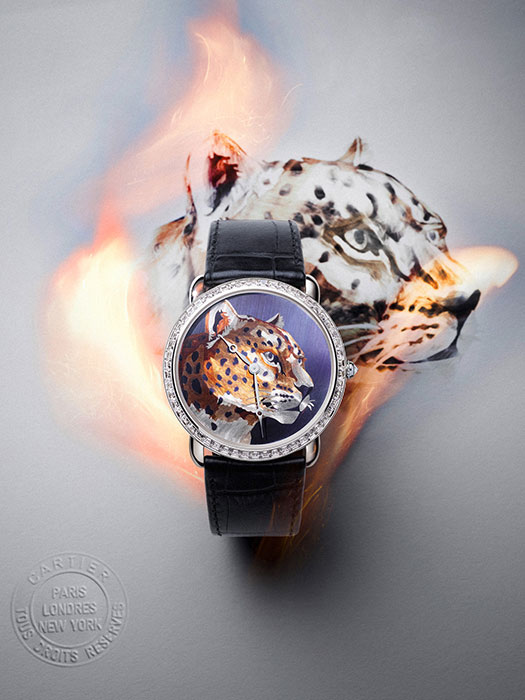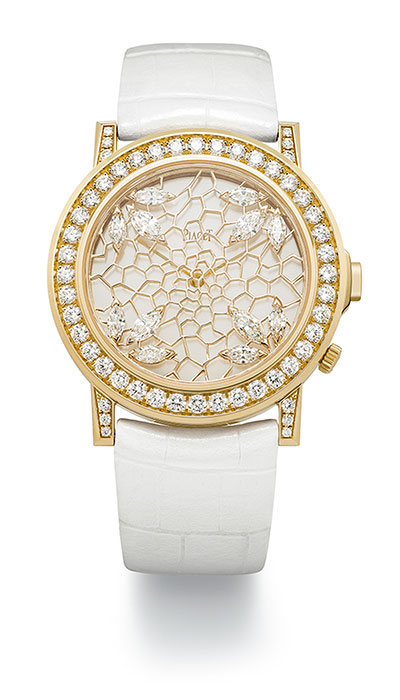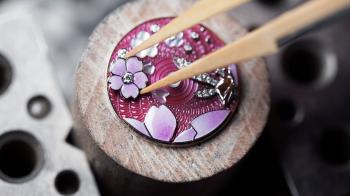Cartier
A watch: Ronde Louis Cartier XL
A technique: Flamed gold
The Cartier’s “Maison des métiers d’art” in La Chaux-de-Fonds brings together all the traditional techniques (gem-setting, polishing, etc.) as well as some forgotten skills (granulation and filigree, for example) that the company is hoping to bring back into favour.
The Ronde Louis Cartier XL watch introduces a technique never before seen in watchmaking, and one that Cartier has recently added to its repertoire of artistic crafts: flamed gold, a technique inspired by the way steel watch hands are blued by exposure to heat. Flamed gold demands perfect mastery of heat, as the colours appear sequentially depending on very precise temperature calibrations. Blue is produced at the highest temperature, and beige at the coolest. The surface of the 18-karat gold watch dial is engraved or “brushed” with the pattern of the panther’s coat. The gold plate is then heated over a flame, and the first colour change occurs. This operation is then repeated as many times as is necessary to achieve the complete colour palette. This painstaking and laborious work also requires a great deal of forethought, as each return to the flame affects all the colours, and each firing could potentially obliterate many hours’ work. The result is a spectrum of rich colours and a strikingly lifelike representation. This rare and precious timepiece is driven by the manually-wound 430 MC calibre. Just 30 are available.

Piaget
A watch: Altiplano Double Jeu Gold Lacework
A technique: Gold lacework
Piaget is well known for its dedication to exceptional craftsmanship and its constant pursuit of the best independent artisans to carry out all the techniques not already available within its manufacture. This year, the company has joined forces with Sara Bran, a self-taught artist who is the only practitioner of her craft: gold lacework. In order to recreate the lightness of lace on the slim rose gold sheet, Sara Bran uses pointed scribing tools and a pair of compasses to trace the designs, drills to pierce holes and saw blades to cut out the metal using a highly specific skill – manual redrilling with a small hacksaw. She opens up empty spaces and gradually eliminates material to reveal a delicately sculpted lacework as fine as a super-thin thread.
The design of the Altiplano Double Jeu with its two superimposed cases (which celebrates its 60th anniversary this year) lends itself perfectly to the lacemaker’s art. The diamond-set upper module is adorned with delicate gold lacework, whose radiating motif is enhanced by marquise-cut diamonds. Beneath this decor, the hours tick by discreetly. A press on the pusher reveals the Altiplano’s white dial, which conceals the hand-wound 430P movement.

Vacheron Constantin
A watch: Métiers d’Art Copernicus Celestial Spheres
A technique: Grand feu enamel
This year, Vacheron Constantin’s master craftsmen have drawn inspiration from one theme – the astronomical universe according to Nicolaus Copernicus – for which they have devised three different dials. The first of the trio gives pride of place to various enamelling techniques. The enameller drew inspiration from the astronomical map of the Copernican system as drawn by Andreas Cellarius, a 17th-century Dutch-German cartographer. The earth in champlevé grand feu enamel reveals the blue of the oceans and the geography of the continents. Against the gold background, a map of the heavens is enamelled in pastel shades, punctuated by fine lines to illustrate the orbits of the five planets. Each planet, represented by a star, is labelled with its Latin name, as are the two solstices. The outer part of the dial features the 12 zodiac signs in coloured enamel. The dial required more than a month’s work and numerous firings at temperatures as high as 850°C before being smoothed, lapped and polished.
The timepiece is equipped with the manufacture calibre 2460 RT, an extremely precise mechanism developed by Vacheron Constantin to reproduce the heliocentric system. WorldTempus’ Editor -in-chief Paul O’Neil explains this new movement with its original display in greater detail here.
The other two dials in the Métiers d’Art Copernicus Celestial Spheres trilogy incorporate both engraving and the combined technique of laser engraving and hand engraving on sapphire crystal.

Van Cleef & Arpels
A watch: Charms Extraordinaire Fée Sakura
Techniques: miniature painting and cabochonné enamel
Through the Extraordinary Dials™ collection, Van Cleef & Arpels offers a poetic interpretation of the passing of time. On a single dial, the artistic crafts meet and combine, forming compositions where every detail bears witness to the creativity of the maison’s artisans. The Charms Extraordinaire Fée Sakura watch brings together two of the Parisian brand’s major sources of inspiration: nature and fairies. On a deep pink background, the dial displays a scene of enchanted nature by means of several artistic crafts: delicate flowers are worked in hand-painted sculpted mother-of-pearl, while the petals in the foreground are adorned with cabochonné enamel. The fairy sculpted in white gold has diamond-set wings and a lively and gracious expression. Around the bezel, two sparkling lines frame a row of pink sapphires in graded hues of pink to emphasise the perfect roundness of the case. As a final touch, a good luck charm swings delicately with every movement of the wrist.











